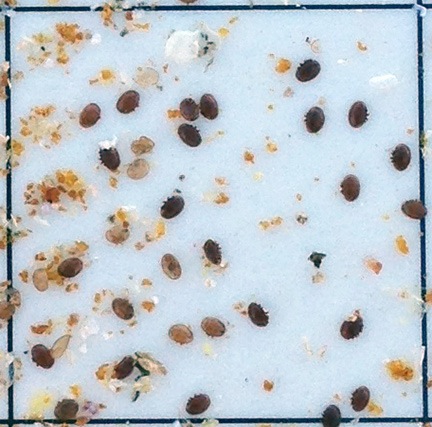Not quite as exciting as the title might make you think, but very pleasant.
I spent a few hours yesterday kayaking in the Columbia River near my home in the Wenatchee area of Washington.
I bought the kayak a few months ago and, in all honesty, have only taken it out a few times. It’s nothing special — a yellow Costco special nicely outfitted for one person on calm water. My first outing was in one of the Quincy lakes with a friend way back in May. Other brief outings followed. But then I got my little jet boat running and started taking that out instead.
A few weeks ago, while out on the jet boat salmon fishing with a friend in the mouth of the Wenatchee River, I noticed a number of people taking kayaks and paddle boards up the Wenatchee River. The spring flow was long over and it hadn’t rained hard enough lately for floodwaters to raise the flow. Indeed, we couldn’t get much farther upstream with the jet boat than the second bridge because of low water. Low water meant slower flowing water. Slow enough for people to take a leisurely paddle upstream.
That’s what gave me the idea to do the same.
Yesterday I headed out with that in mind. I had a five hour window before I had to be back at the helicopter for an afternoon charter flight. Just enough time for a paddle and a shower.
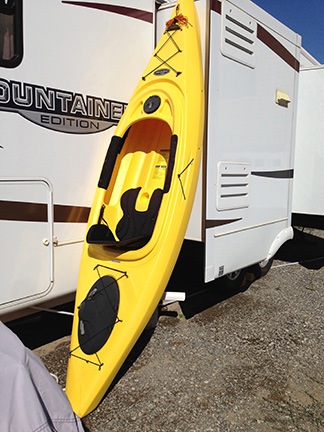
Washing the kayak is as easy as standing it up in the corner and hosing it out.
I started off by washing the kayak. It had been stored under my RV for over a month and I didn’t want to think of the creepy crawlies that might be in there. Better to just hose it out. So I propped it up against a corner of my RV, connected a spray nozzle to the outside shower, and gave it a good rinsing, letting the water drain through a normally plugged hole on one end. I let it dry while I packed a tote bag with a few things.
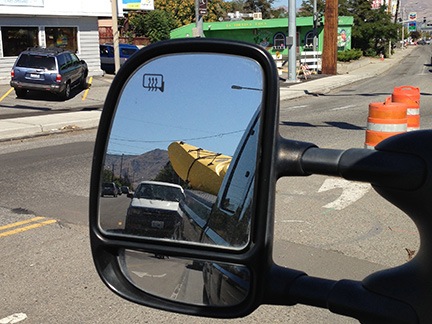
I can keep an eye on the kayak in my truck’s mirrors.
Loading the kayak into the back of my pickup isn’t difficult. I lift one end into the bed over the closed tailgate and push it as far forward in the truck as I can. Then I angle the body of the kayak diagonally across the bed. I secure it in place with a bungee cord attached to a corner tie-off hoop built into the truck. It doesn’t move more than an inch in either direction during the drive; I can watch it in the truck’s mirrors.
One of the things I absolutely love about this area of Washington is the sheer variety of outdoor activities available. The Columbia River is a source of many of these activities: boating, fishing, swimming. There’s even an 11-mile bike/hike/skate trail that goes down one side of the river, crosses a bridge, comes back along the other side, and crosses a second bridge to return to a starting point. Parking is free in the loop trail parking lots or any of the parks along the river in Wenatchee or East Wenatchee. There are three boat ramps within a 20-minute drive of my home — all free with plenty of trailer parking.

The area where I kayaked on Sunday.
I decided to put in near the swimming beach at Walla Walla Point Park, which is about 15-20 minutes away from my home. The beach is protected from the river’s main flow by a sort of jetty with a path on it. You can see it in the lower-right corner of this satellite image. I chose this area because I could back the truck pretty close to the water and the little lagoon was a good, calm spot to launch.
I dragged the boat across the grass and down the beach to the water. I put Penny’s life jacket on her and stowed my life jacket and tote bag in the boat. Then I put Penny in the boat, pushed off a bit, and climbed in after her. A moment later, we were gliding across the lagoon. It was about 11 AM.
I could feel my arm muscles working hard right from the start — but not nearly as hard as they had to work when I exited the lagoon and got into the Columbia River’s main flow. There was some shallow water then and the river rushed over it. I had to paddle hard to get through it. I started to think that I’d never reach the mouth of the Wenatchee River about a mile or so to the north.
But then I got through it and into calmer water. I still had to paddle hard to stay ahead of the current, but it wasn’t a frantic paddling. I stayed close to shore and the water got calm. I might make it after all.
The satellite image above shows the river with the water at a higher level. Northwest of where I put in is an area that reminds me of the marshes in Newark, NJ. You know — where the NJ Turnpike goes past the Meadowlands? The difference here is that the water isn’t tidal. The little side inlets exist only as long as the river’s water level is deep enough. Although the image shows lots of watery passages between trees, on Sunday there was only one channel that went through to the mouth of the Wenatchee.
I know this because I found it. I didn’t have a map or satellite image. Instead, I just paddled close to shore, saw an opening in the trees, and decided to explore. What I found was a calm water passage surrounded by trees and water weeds and inhabited by ducks and herons. The water was glassy smooth and shallow — in some places barely deep enough to paddle over. There was the tiniest bit of current to convince me to keep moving forward, that water had to be coming in from somewhere.
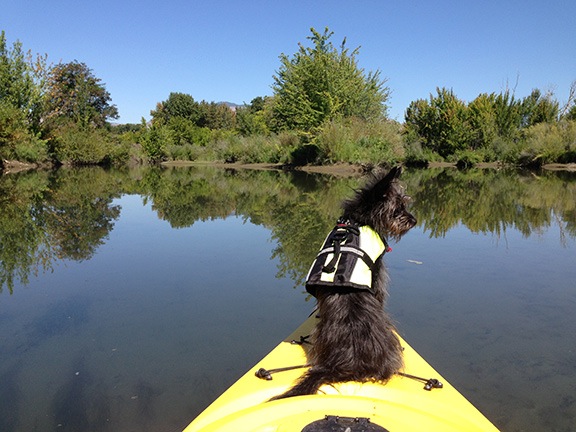
Penny rode on the forward deck as I paddled us through glassy smooth water.
It was sort of magical in there. Quiet and private, with the occasional sound of a motorboat out in the main channel of the river to remind you that you weren’t paddling the remote Amazon. Trees hanging over the narrow parts of the waterway gave us cooling shade every now and then. Bubbles and bits of debris on the water surface cast shadows on the sandy bottom, assuring me that the water was indeed moving in the opposite direction I was.
Near the end of the waterway, we met up with a man on an inflatable boat with oars. He was alone but talking to someone. At first, I thought it was me. But then when we got near him he laughed, held up his smartphone, and said that he was sharing a virtual float trip with friends in Georgia.
The world is getting smaller.
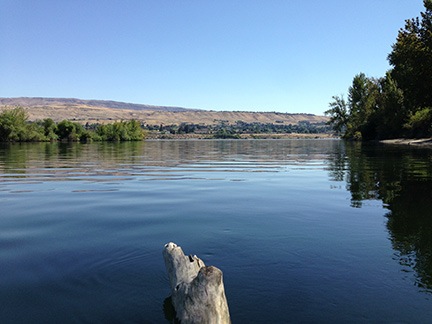
Parked up against a log, looked down the Wenatchee River and across the Columbia River to the far shore in East Wenatchee.
The waterway dumped us out at the mouth of the Wenatchee River. I turned left and started paddling up that river. There wasn’t much current, but there was more than there had been for the past 30 minutes. I paddled upstream on the south side, pausing when I reached a log jutting out of the water. I pulled in upstream from it and let the current take me downstream until the kayak was lodged against it. I rested there and tweeted a photo (as I so often do) and took in the calmness of the rivers around me.
How can anyone not like this area? It’s got the dry air of the desert but is full of water. It rains, but not too often. It gets hot, but not too hot. It gets cold but not too cold. And all around are beautiful mountains and forests and orchards and farms and rivers and lakes. Boating, fishing, hiking, motorcycling, biking, wine tasting. Beautiful sunrises and sunsets, magnificent thunderstorms, star-filled skies. Quiet, private places to live and work. A major city less than an hour away by air or three hours away by car. And people who are friendly and happy and youthful — even if they’re not exactly young anymore.
How did I live in Arizona for so long when I had this to tempt me for five consecutive summers?
(Well, I know the answer to that question but we won’t go there.)
Finished with my rest, I paddled across the Wenatchee River into one of the water channels on the opposite shore. I paddled around on that side down one channel and up another before finding a third to take me back out to the Wenatchee River again. Along the way we saw Canada geese, seagulls, and killdeer. Penny barked at the geese.
I crossed the Wenatchee River again and headed back into my quiet waterway for the return trip to the park. This time some kids were walking along one of the sandbars, catching fish in a cutoff milk jug while a man paddled a canoe. As I paddled past him, he said, “I see your dog is getting you come exercise.” I laughed and told him she was guiding me.
Back out in the main flow of the Columbia River, I let the current do some of the work for me. I had to paddle hard to get around the tip of the jetty and back into the swimming lagoon. There were lots of people there now, kids swimming in the designated area, dogs fetching balls in the water nearby. I paddled up to shore and we got out. I ran into a friend of mine and chatted for a while before dragging the kayak back to the truck.
By 2 PM, I was back home prepping for that afternoon’s flight. It had been another great day out.

 There’s an excellent cheese shop not far from where I live:
There’s an excellent cheese shop not far from where I live: 